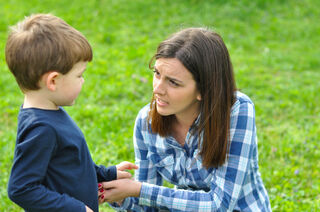Emotion Regulation
Children Need to Talk About Their Emotions
They need grown-ups to help them.
Posted November 2, 2020

By Jill Leibowitz, Psy.D.
We are living through unprecedented times and there’s a lot we can’t control right now. With daily life altered immensely, many parents feel helpless and worried about their children’s academic and social-emotional development. But there’s actually a lot we can do to help our children, and a primary way we can support them is to focus on their emotional growth. Now, more than ever, it is important to help children talk about their feelings.
Children need grown-ups to help regulate their emotions
In order for children to be able to learn, grow, and develop, they have to be able to regulate their emotions so that their mental resources are available for learning. Emotion regulation refers to the ability to control our emotional reactions and subsequent behavioral responses to them.
For example, a child who is panicked about being in the water will not be able to focus their attention on the swimming lessons being taught.
Emotion regulation is facilitated when grown-ups provide safe opportunities for children to express their feelings and engage in accepting and reflective dialogue about them.
Talking about feelings helps organize experience
Putting our feelings into words helps organize experiences that might otherwise feel chaotic and overwhelming. It allows us to understand what and why we feel the way we do, and this understanding helps us have the calm needed to make decisions about how to respond.
Verbalizing our emotional experiences moves them from the primitive, reactive portions of our brain to the higher-level control centers of our brain. When we engage in emotion-themed dialogues with children—when we think, talk, and reflect on their feelings with them, we help them regulate their emotional experiences.
Albert was in the third grade last spring when the NYC lockdown began. It was hard for him to stay focused and attend during remote learning, and his teacher frequently reprimanded him for acting out during Zoom classes.
During our video therapy sessions, he expressed fear, uncertainty, and helplessness related to COVID-19, as well as sadness, anger, and frustration that he couldn’t see his friends and family members in person. His mother joined us during several video sessions, where we spoke together about how scary the COVID-19 pandemic was, and we considered all of the rapid changes that had occurred in Albert’s life as a result.
His mother and I reflected with Albert on his many big feelings. We spoke together about why those feelings made sense, and we considered productive and creative ways that Albert could channel his fear, anger, and frustration that wouldn’t lead to reprimands and punishments. Albert’s classroom behavior improved, and he felt happier and less angry overall.
Key points to facilitate safe, reflective emotion-themed dialogue with children
Name the feelings you think your child is expressing. For example, “It seems you are really angry/sad/scared/worried right now.” Identifying and naming their feelings helps children feel more in control and less overwhelmed by them. Be open to your child correcting you if you get the feeling wrong.
Validate the feelings your child is expressing, even if they don’t make sense to you. For example, “You feel scared to stay in your bed right now. Even though your bedroom door is open and I am right down the hall, you still feel scared when you go to bed. It can feel scary to be alone at night.”
Be curious about their feelings, and expand the dialogue. For example, “Wow, you’re really mad that you have to take a bath right now. You usually enjoy baths. I wonder why you’re so mad this time? Maybe you’re angry because you had to stop playing that video game in order to take the bath. It’s hard when we have to stop doing something fun for something else.”
Offer ways of coping. For the fearful sleeper mentioned above, you might say, “Let’s think together about what might help you feel less scared while in bed.” For the angry bather, you might make a plan to do something fun together after the bath. Sometimes, when a child’s feelings are really big, it can be helpful to have them discharge the feelings physically by moving their body in a safe and playful manner. Some examples include:
- ripping or cutting paper;
- pressing hard while coloring with crayons;
- throwing a ball, or hitting hockey pucks or tennis balls, etc.
- rough and tumble play.
For some children, activities that quiet the mind and body are more helpful. These include:
- mindfulness activities, such as deep breathing;
- focusing attention on positive past or upcoming events;
- thinking about things for which they feel grateful.
Grown-ups need self-care, too
For children to feel safe engaging in emotion-themed dialogues, it is important that we, the grown-ups, regulate our own big feelings. Often, that means taking deep breaths first, so that we can identify and validate our own emotional experiences before helping our children.
Once we recognize our own frustration with our child who won’t go to bed or take their bath at the end of a long and stressful day, we are then freed up to consider what might be going on for them at the end of an equally long and stressful day. And if we’re having a hard time regulating our emotional experiences on our own, it might be a signal that it’s time to seek support from family, friends, or a therapist.
Jill Leibowitz, Psy.D. is the author of The Untold Story of Itsy Bitsy’s Long, Emotional Day, a children’s picture book that can be used as a starting point for emotion-themed dialogue between children and their grown-ups.




